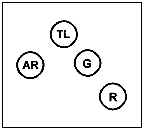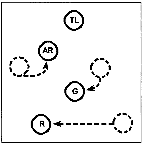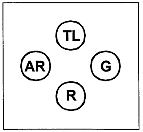
Move It or Lose It
Movement is obviously integral to Battlefield Live, airsoft, paintball, traditional lasertag or any other activity that doesn't include being comatose. We've put together a few notes on "proper" movement that we thought would be useful.
| Bounding Overwatch | - The most important movement technique you can possibly learn |
| Military Movement | - Fireteam movement formations and more |
| Police Movement | - They don't work in squads, so how do they move differently? |
Bounding Overwatch
The bounding overwatch is one of the most important techniques to master if you want to advance upfield. Before you start bounding you should have your whole team (or as much of it as you want to move together) close together in a small area. Half of the team starts by providing suppressive fire and watching for opponents while the second half moves to another location under cover. Once they arrive they provide cover fire for the first half of the team.
Bounding is difficult! The coordination required to bound correctly requires a team that is willing and able to work together, as well as good communication. A successful bound depends on several factors:
- The overwatch keeps their eyes open and maintains fire superiority over the opposition
- The bounders donít bound into or across the line of fire
- The bounders make an effective transition to become the overwatch
- The original overwatch is alert enough to notice that the bounders have become the overwatch and take the opportunity to move
The full process goes somewhat as follows:
- The team leader identifies where threats are likely to come from and where the team needs to go.
- The team leader divides his team into two groups. (Realistically, this step should be done in advance, so that when a bounding order is given the team knows who is moving first, but the step can be done no later than at this point.)
- The team leader gives the command "BOUND!" and clearly indicates where the team will be bounding, either by describing or pointing clearly. The team leader should also indicate the direction(s) of likely threats.
- The half of the team that's moving first (the bounding group, which includes the team leader) responds to the team leader, "BOUNDING!"
- The half of the team staying behind (the overwatch group) moves into a position (whether aiming over cover or around a corner) where they will be able to provide cover fire for the movement of the bounding group.
- Once the overwatch group is in position the overwatch group leader tells the team leader, "MOVE!"
- The team leader moves quickly to the new position. The bounding group moves with him. The bounding team does not take cover but holds a position to provide cover fire for the overwatch group.
- The team leader signals to the overwatch group, "BOUND!"
- The overwatch leader responds, "BOUNDING!"
- The team leader orders, "MOVE!"
- The overwatch group regroups with the bounding group. All team members maintain an active watch for opponents.
Back to the top or Tactics page.
How does the military move in groups?
The U.S. Army tends to move in combat using fire teams of four soldiers. Each person in the fireteam has a role that they focus on. Those roles are team leader, automatic (heavy) rifleman, grenadier and rifleman. Unless they are sure of their environment they move exclusively by bounding. Several fireteams will communicate by hand gestures and radio to coordinate their movement but each fireteam is responsible for providing its own overwatch for its respective bounding.
When walking in a patrol formation one soldier will walk point, ahead of the rest of the squad. The point soldier is looking for ambushes and any other clues of opposing presences. The rest of the soldiers will fan out behind. Why do they do this? A single column is easy to ambush. If you simply hide near their path they'll flank themselves for you. A wide, staggered column, however, is very difficult to ambush because it is hard to get a good firing line for every member of the column at once. If you can't take targets out of the fight before they can get to good cover then you no longer have an advantage. For the same reason a single soldier will also often walk to the rear of the group, to detect trailing opponents.
Incidentally, Mikeís watched U.S. Marines defend their base while playing in this same way. One Marine stood out ahead of the base and the other four split up and sat behind the flag, two on each side. In short, the military uses the same techniques that are described on this page exactly the same way that top Battlefield Live, paintball and airsoft players use them.
As we discussed above, the military moves in a bounding overwatch any time they are not absolutely sure of their surroundings. We also discussed in this section the use of fireteams. So how do those fireteams normally walk in formation with one another? If they're simply sneaking through the underbrush, what shape do they keep? The answer: several, actually. We've taken the following from US Army Publication STP 7.11B1.
 |
Wedge Formation |
This is the basic fire team formation. It has the following characteristics:
|
|
 |
Modified Wedge |
When rough terrain, poor visibility, or other factors reduce control of the wedge formation, the sides are closed up to (almost) a single file. When moving in less rugged terrain and control becomes easier, soldiers resume their original positions. The modified wedge can also be used for extended periods when traveling on roads or trails. It has the following characteristics:
|
|
 |
Diamond Formation |
This formation is a variation of the wedge. It is most often used when the fire team is operating alone or is the lead security element (point) for a column or file. It has the same characteristics as a wedge except there is...
|
|
 |
File Formation |
When the fire team is not using a wedge or diamond formation, it usesthe file. The characteristics of the file are as follows:
|
Back to the top or Tactics page.
How do the police move?
SWAT teams use military tactics and larger fireteams and squads, but patrol officers are often out only with a single partner. Although police will still use the same tactics overall that the military and SWAT use they adapt the techniques for use by a single pair of people.
The challenge with the police-style approach is that it is not intended for full combat, but only for encounters against small numbers of opponents. Don't believe us? Try to play a game of 2-man Free-For-All and don't just win, but make sure that both you and your partner are still alive at the end. Larger teams can have a lot more flexibility to address varied threats and respond to multidirectional assault, provided that they are led by a strong leader and the team members listen.
Back to the top or Tactics page.








